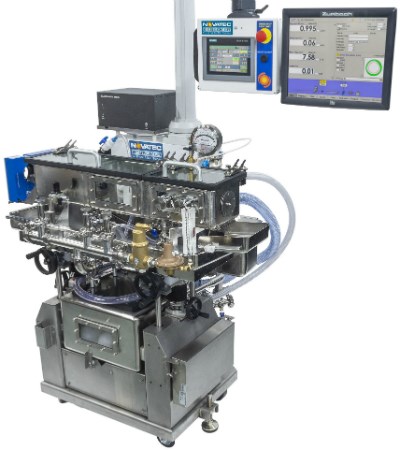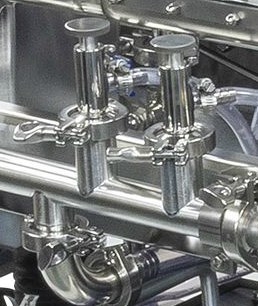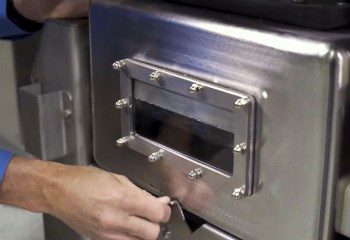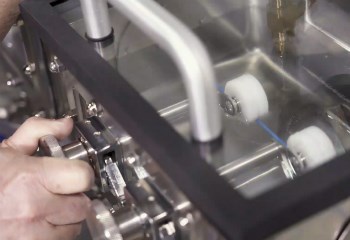No-Compromise Extrusion Water and Vacuum Tanks Designed for Medical Tubing
Sponsored ContentDownstream extrusion equipment expert Bob Bessemer set out to design the perfect water and vacuum sizing tanks for medical tubing. He just may have pulled it off.
Share
Read Next

If you’re familiar with downstream extrusion equipment, chances are you’re familiar with the work of Bob Bessemer. He’s been designing cooling and sizing tanks, pullers, and cutters for over 35 years and has numerous patents in this equipment to his name. Last year Bob joined his brother Conrad Bessemer, president of Novatec, with a new mission in mind: design a completely new line of downstream extrusion equipment for processors of medical microbore tubing, without compromises in features and functions necessary for this demanding industry.

But Bessemer didn’t do it alone. He regularly consulted with elite extrusion experts such as Larry Alpert—a long-time medical-tubing processor who now runs his own consulting company, Med1Extrusion—to get a thorough understanding of equipment needs from the user perspective. The result is the Bessemer Rx-SmartMED Series, a new line of water and vacuum tanks that are available in 3-, 5-, and 8-ft. lengths. Also coming out later this year is the NPC Micro-Medical Puller/Cutter Series. Both have been designed from the ground up for the requirements of extruded single- and multi-lumen microbore tubing.
Tanks Designed for Cleanability

Sanitary fittings have no threaded surfaces that can trap bacteria.
Medical extruders are accustomed to stringent cleanroom standards and tight-tolerance requirements for producing medical tubing. “They go through many pains to meet the exacting standards of their process with the equipment available on the market today,” says Bob Bessemer. Two important requirements are for tanks to be easier and quicker to clean and to stay clean longer.
To that end, almost every surface and component of the MVT Series Medical Vacuum Tanks are made of stainless steel. All water contact surfaces are electropolished and have rounded corners, which make the units easier to clean, and more resistant to the buildup of bacteria and biofilms in the first place. The “tri-clover” fittings and valves, also known as “sanitary fittings,” are stainless steel as well, and have no threaded surfaces that can trap bacteria, as is common with more conventional designs that are virtually impossible to clean. “The fittings and valves we use are standard in the various beverage industries, but not for tanks that produce heart and brain catheters? That didn’t make sense to us, so we made them standard on the Novatec tanks,” Bessemer says.

The vacuum section slides out for easy maintenance.
Quick system flushing and draining to pump the entire system dry is accomplished with the water pump and the addition of a three-way water valve. According to expert processor, Larry Alpert, “The vacuum section easily pulls out. You can take your heat exchangers out, you can wipe everything down, you can get at everything, and then you can reassemble it. Basically, it’s a toolless operation to re-flush and refill and then use the tank. It should cut down the amount of time it takes to service a tank by less than half.”
Bob Bessemer and Larry Alpert discuss the need for precision vacuum control.
Precise and Efficient
The MVT Series Medical Vacuum Tanks were designed to meet the critical ovality and concentricity requirements of single- and multi-lumen microbore tubing. As Bessemer puts it, he and Alpert set out to turn what had been guesswork into science through better process controls, which in turn create a higher level of process precision and repeatability than has ever been possible before. Some of the ways they accomplished that objective include:
- Digital closed-loop vacuum control – Controlling vacuum level is key to holding tight tube diameter tolerances demanded by the medical industry. The tanks use a vacuum transducer with double the resolution of previous units. It can control the vacuum within +/- 0.01 inches of water instead of 0.1 inches with previous units.
- Servo linear actuator to control the “hot gap” – The distance between the extruder die and the entrance to the water or vacuum tank can be a critical quality factor—particularly in microbore tubing—and is typically considered a process validation point in the medical industry. To create more precise and repeatable control of the gap, Novatec replaced the old handwheel positioning device with a linear actuator that is accurate to a few thousandths of an inch. It allows an operator to back off the tank 6 inches to string up a new job and then precisely set or reset the gap at the touch of a button.
- Standard medical-grade filtration – Sterile applications such as heart or brain catheter tubing place stringent demands on the tank filtration system. The Novatec tanks use a two-phase system with a UV filter to kill bacteria and then a membrane filter as small as 0.5 microns to remove pyrogens.
- Water circulation system –The unique system minimizes water cavitation, which creates micro-water bubbles that can cause tubing surface imperfections and ultrasonic gauging issues. Bessemer’s design places the water pump below the reservoirs to make it self-priming, which dramatically reduces cavitation issues from that source. Moreover, it uses an AC inverter to drive the pump motor for precise RPM control. Besides being able to fine-tune pump pressure for different vacuum levels, it also allows the processor to set a lower nighttime circulation rate to save energy and further minimize stagnation.
The servo linear actuator controls the hot gap to a few thousandths of an inch.
Flexible Operation
An age-old compromise of a vacuum tank is that it hasn’t worked well as an open tank, even though many processors aren’t running vacuum all the time. Though Bessemer concedes the improvements in the circulation system weren’t aimed at this purpose, they have indeed enabled this collateral benefit. The system naturally creates a small measure of head pressure that makes the water flow from the open to the closed section very easily, and without creating cavitation issues. Processors benefit from being able to move instantly from vacuum to non-vacuum mode without having to change out the tank.

Rollers can be positioned from outside the vacuum tank.
Another factor in enhancing usability is the externally adjustable roller system. According to Alpert, “the last thing you want to do is open the cover and adjust your roller, especially when you are using a vacuum to control tube OD and ovality.” With the external roller system control, the operator can adjust the roller position and see the result through the glass viewing window. Setup and in-process adjustments can be made quickly and accurately, while keeping the operator’s hands out of the water, thus eliminating the likely transfer of bacteria from the old approach.
The design also features a new tooling interlocking system that requires no tools and exposes no threads to process water. Installation simply requires placing the tooling plate over the locking pins and then rotating the plate. Each plate has an O-ring in the back to seal the connection and prevent air bubbles from getting into the process. The tooling is being designed for a wide range of configurations, such as bushings and iris apertures, all with the interchangeable mounting plate shape.
The interlocking tooling system requires no tools to mount or dismount.
Controls for Now and the Future
The new downstream equipment is a next-generation IoT-enabled product line, leveraging technology from Siemens and MachineSense, a subsidiary of Novatec and a Gold Partner in Siemens’ MindSphere Partner Program. MindSphere is the cloud-based, open IoT (Internet of Things) operating system from Siemens that connects products, machine systems, and plants. This helps enable businesses to harness the wealth of data generated by IoT with advanced analytics and state-of-the-art features that allow the Bessemer Rx-SmartMED Series to provide:
- Secure connectivity and data management
- Out-of-the-box custom analytics that drive operational insight
- Real-time machine health monitoring that significantly reduces unplanned downtime and maintenance costs
- Insights from machine data that enhance workflows, inter-operability, and facilitates new business models
With so much of the downstream extrusion process now under precise computer control, Bessemer and Alpert have indeed met their objective of turning guesswork into science. Add in all the serviceability features and the Rx-SmartMED Series offers an entirely new level of downstream extrusion equipment performance, all standard, and in a cost-effective package.
Get more information here.
